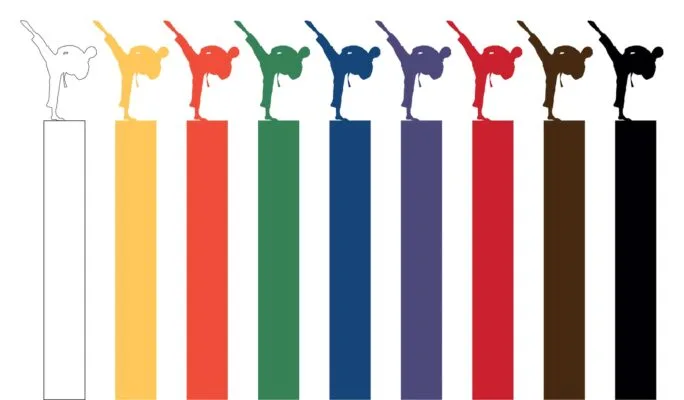
Most people find the karate belt ranking system a bit confusing because there are many different styles and forms. You may wonder, how the karate belt system actually works. Does it vary between different karate styles? Or how long does it take to progress from one belt to the other?
White, yellow, orange, green, blue, purple, red (in some karate styles), brown, and black are the most common colors in the karate belt ranking system. Upon black belt, there are 10 dan ranks that go from the 1st dan belt to the 10th dan black belt, which is the highest rank in karate.
Keep reading this article to learn more about the karate belt ranking system and its unique features.
Origin of Karate Belts
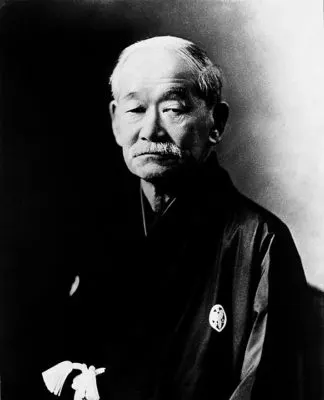
The origins of karate belt ranks come from Judo, and the famous color belt ranking system created by Kano Jigoro, a father of Judo. Jigoro took the inspiration from the popular board game called “go”, which is quite similar to chess, to create Judo grades. In the beginning, the belt system created by Jigoro had only three colors: white, brown, and black. But over the years, the ranking system has evolved and the number of grades and belts has increased.
The man who took the grading system from judo to implement it in karate was Gichin Fukanoshi, and he did it in 1924. However, there is another theory.
According to the legend, each karate student was given a white belt at the start of their journey and was told to never wash their belt. Over time, the belt would become dirty with sweat, blood, dirt, and change colors. Once it would become all black, it was considered that the student had reached a black belt rank. Although this story sounds interesting, it is far from being true.
RECOMMENDED FOR YOU: How to Wash White BJJ Gi and Remove Stains
What Is The Order Of Belts In Karate?
In most karate styles like Shotokan and Wado-Ryu, there are two different groups of belt ranks. The first one is “kyu grades” where students start their journey, and the second is “dan grades” for advanced students that wear a black belt.
Kyu ranks are ranked in the following order:
- White belt – 10th kyu
- Yellow belt – 9th kyu
- Orange belt – 8th kyu
- Green belt – 7th kyu
- Blue belt – 6th kyu
- Purple belt – 5th kyu
- Red belt – 4th kyu *not in all styles
- Brown belt – 3rd kyu
- Brown belt – 2nd kyu
- Brown belt (with Black middle stripe) – 1st kyu
- Black Belt (1st to 10th dan)
Dan belts are ranked in the following order:
- Shodan (1st dan)
- Nidan (2nd dan)
- Sandan (3rd dan)
- Yondan (4th dan)
- Godan (5th dan)
- Rokudan (6th dan)
- Nanadan (7th dan)
- Hachidan (8th dan)
- Kyudan (9th dan)
- Judan (10th dan)
What Is The Difference Between Kyu and Dan Grades In Karate?
Kyu ranks are for students who are still learning techniques and are below the black belt rank. Dan ranks begin where Kyu ends, and are for masters of karate who have already reached a black belt rank. Here is a detailed explanation of both:
- Kyu in Japanese means “class” and in karate, it indicates the levels below the black belt rank. The kyu ranking system and its structure vary between schools, styles of karate, and schools. In most karate dojos and styles, there are 10 kyu ranks, with the 10th being the beginner level, and the 1st being a black belt rank. Once a new student joins a karate dojo, they would receive a white belt (10th kyu rank). Over time, they would progress through nine more kyu ranks before they reach the 1st kyu rank, which is a black belt.
- Dan in Japanese means “Step” or “grade” and in karate, it represents a grading system that begins once a student reaches a black belt rank. Students who made a progression through all kyu ranks and have earned a black belt now move to dan ranks. Dan ranks are basically 10 different black belts where the lowest ranks is the 1st dan black belt and the highest one is the 10th dan black belt.
What Is The Highest Rank in Karate?
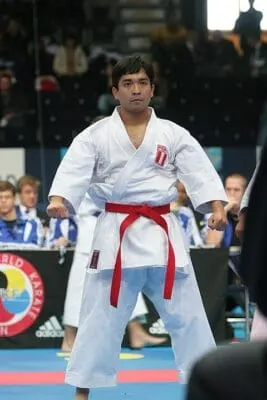
Photo by Indrek Galetin
A black belt is widely considered to be the highest rank belt. But since karate has many styles and forms, this rule may vary and not all karate schools adhere to a black belt being the highest rank
In some karate schools, 10th dan is actually a red belt. In traditional karate developed in Okinawan Islands, the red belt was the highest rank. It indicates the highest level of competence, technique, and reputation of a master. That being said, the highest kyu rank is always the black belt for all karate schools.
In other cases, the red belt is the second-highest belt in some styles like Shorinkan karate and it is presented to a student when they reach a 9th dan rank (kyudan), with the black belt being the highest, 10th dan rank. On the other hand, a red belt is sometimes a part of kyu ranking system for beginners. In contrast, a lot of red belts are also awarded posthumously.
What’s The Meaning of Karate’s Different Belt Colors?
Unbeknownst to most people, the different belt colors in karate represent the growth stages of the plant. What do different colors represent? Let’s take a closer look:
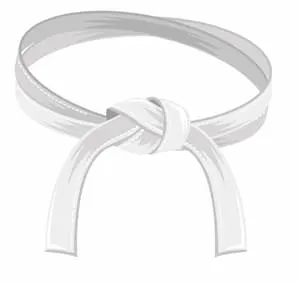
White (the birth of new light) — is worn by beginner students in the opening months of their karate journey.
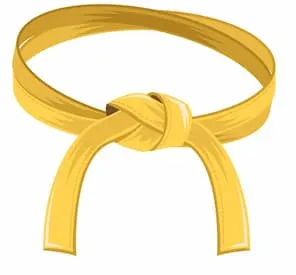
Yellow belt (the first beams of sunlight) — is still a beginner belt worn by the students who have mastered the basics and want to continue learning. This is also a level where they start light contact sparring with the emphasis being on discipline, stances, and mixing kicks with punches.
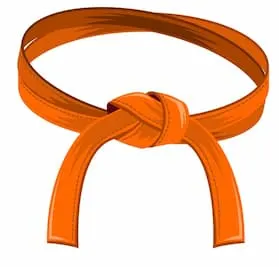
Orange belt (growing strength of the sun) — in most schools, students receive an orange belt once they have mastered the famous 10 karate self-defense moves.
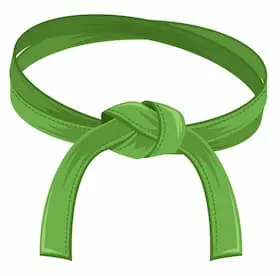
Green belt (growth of seeds and plants) — is a level where students start to learn more complex techniques. The emphasis is on learning how to mix punches and kicks with grappling moves.
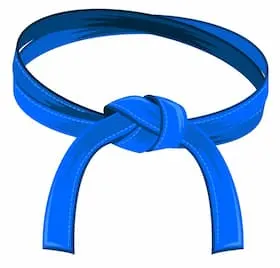
Blue belt (the plant is growing towards the blue sky) — at this level, students learn how to apply techniques in real sparring. After mastering this level, they will be capable of applying karate moves in a real fight.
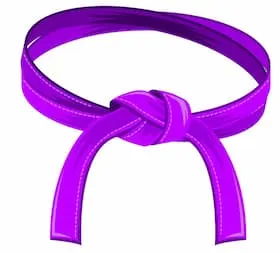
Purple belt (colors of dawn) – is a belt worn by karatekas who are slowly transitioning to the advanced levels of karate learning.
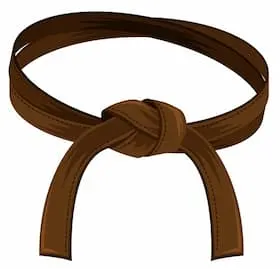
Brown belt (the plant is grown and ready for harvesting) — is a belt worn by students who are maturing and are mastering the techniques to perfection. It is also a level where a student is ready for real combat.
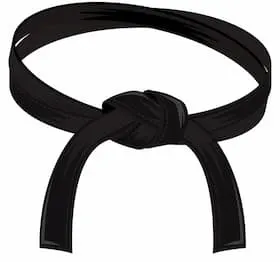
Black Belt (darkness beyond the sun) — is the ultimate kyu rank in karate reserved for students who have mastered all the techniques and have a deep understanding of both mental and physical aspects of karate. This is also a level where they start teaching and helping other students in their progression through the ranks.
RELATED: Taekwondo Belt Ranking System – EASILY Explained For Beginners
How Long Does It Take To Get A Black Belt In Karate?
On average, students need around 3 to 5 years of hard training to progress through the kyu grading system and reach a black belt rank. Of course, the number of years may vary as it all depends on many factors like your talent, passion, and dedication to training. It is an individual thing as some students have the ability to learn faster while others may struggle or get stuck at a certain level.
A student who attends the classes twice per week would not progress as fast as a student who trains five times a week, follows a strict diet, and is always working on their strength and conditioning. But even in the ideal scenario, do not expect to earn a black belt in less than 3 years.
Also, how long does it take to get a black belt also depends on the style of karate, the school you train in, the quality of coaching staff, and promotional criteria. Some karate dojos are full of black belts which is the best indicator that promotional criteria in that dojo is low. This means that you can reach a black belt rank in a short time span, but you won’t be as proficient in karate as black belts from other schools where the promotional criteria is very strict.
RECOMMENDED FOR YOU: BJJ Black Belt Lineage – Why It’s Important To Verify
How Hard Is It To Get A Black Belt In Karate?
Earning a black belt rank in any martial art is very hard and the same stands for most karate styles. Regardless of your talent, fitness, dedication, and ability to learn fast, you would still need around 4 years to reach a black belt because the promotional criteria are very strict.
But on the other side, bear in mind that karate training is not that hard on your body and is not as dangerous as in other arts. Most styles emphasize light contact sparring, except for Kyokushin which is the hardest style. Rather than sparring full contact all the time, students actually do a lot of katas. These are the sets of pre-arranged forms where students perform techniques alone without a partner. Most techniques are direct, simple, and you won’t have a hard time picking up the basics and progressing through the ranks.
Karate is also not that intense and physically demanding. Yes, you have to be fit and students do a lot of running and bodyweight exercises like push-ups or sit-ups to get in shape. But these workouts are not as intense as the ones in other martial arts like Muay Thai or boxing for instance.
RECOMMENDED FOR YOU: Karate vs. Taekwondo: Key Differences And Similarities
How Long Does It Take To Get Each Belt In Karate?
Here is a detailed explanation of how long it takes to get each belt in karate according to the traditional Shotokan curriculum:
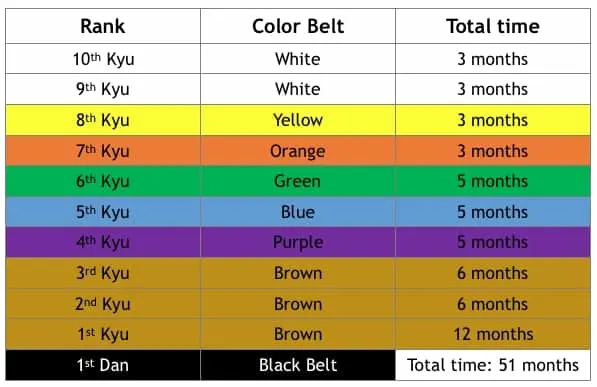
What Is The Hardest Style of Karate?
Karate has many styles and forms out of which Kyokushin karate is the hardest and most dangerous. In short, it is a full-contact style created in the 1950s by the famous karateka, Masutatsu Oyama in Japan.
It is not just the hardest style of karate, but also the most dangerous one. Training is brutal and intense and carries a really high risk of injuries. Each dojo embraces a hard method of training where students spar full contact without any gear. They do not wear gloves, shin pads, or helmets and this is what makes Kyokushin so brutal.
The emphasis is on powerful kicks and punching the upper body area below the neck. But despite the lack of punches to the head, Kyokushin is hard on your body and people trained in this style of karate are among the strongest people. Although it is much harder than other styles, the time required to move from one color belt to another is very much the same as in all other styles.
RECOMMENDED FOR YOU: What Is American Kickboxing? Here’s What You Should Know
What Are The Different Styles Of Karate?
Karate is a very popular martial art that has dozens of different styles and forms. But it is crucial to know that out of all styles, the following four are major ones.
- Shotokan — is the most popular karate style created by Gichin Funakoshi, a man often considered a pioneer of karate in Japan. He created Shotokan in 1938 with an emphasis on wide stances, fast movements, and quick attacks using punches, elbows, kicks, and knees.
- Wado-Ryu — was created in 1939 in Japan by Hironori Otsuka. It is a style that originates from Shotokan and Shito-Ryu, notably when it comes to striking techniques. But, Wado-Ryu also emphasizes joint locks and powerful throws that come from Ju-Jitsu.
- Shito-Ryu — is a style created by Kenwa Mabuni in 1934. It is widely regarded as a very technical style that consists of over 94 different katas student need to master. The emphasis is on striking using all limbs as weapons.
- Goju-Ryu — was developed in 1930 by Chojun Miyagi as a mix of striking and grappling techniques. The emphasis is on circular and linear movements and fast counter attacks.
These four styles might visually look the same. But at the same time differ a lot in terms of emphasis, history, techniques, and methods of training. Also, their four major styles of karate have influenced the birth of many other styles like:
- Kyokushin
- Shorin-Ryu
- Enshin
- Uechi-Ryu
RECOMMENDED FOR YOU: What Are The Different Styles of Karate? Simply Explained
